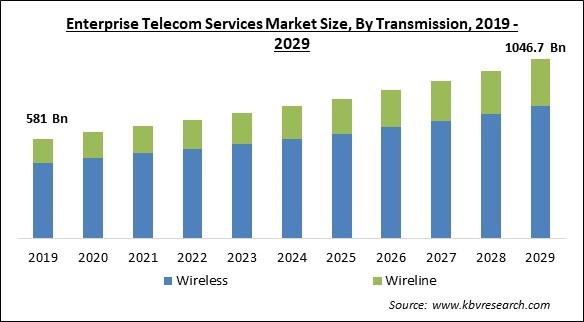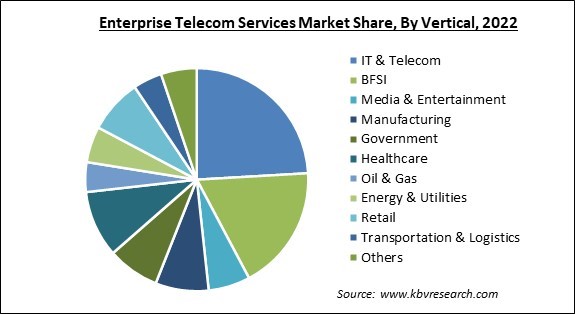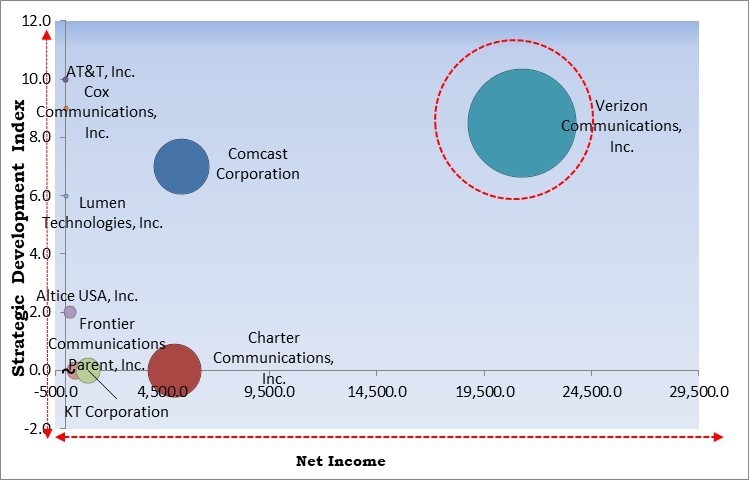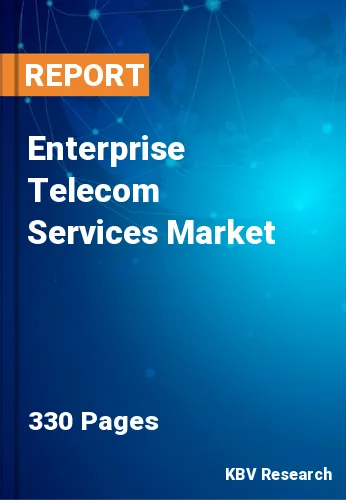The Global Enterprise Telecom Services Market size is expected to reach $1046.7 billion by 2029, rising at a market growth of 6.2% CAGR during the forecast period.
Telecommunications services, which are very beneficial for businesses, enable the ability to communicate with clients effectively and develop strong ties with them. Because they make data transmission easier, increase productivity, and provide flexibility, telecommunications services additionally help employees.

One of the key factors propelling the market's expansion is the increase in investment in the rollout of 5G infrastructure due to a constant shift in businesses' preferences for next-generation communication technologies. In addition, an increase in interest in high-speed data connectivity, a rise in mobile users, and a rise in the need for value-added managed services are the primary factors promoting the market's growth.
Many enterprise telecom service providers are putting their focus on creating technologies through forming alliances that will enable smooth business operations. Through these alliances, service providers can better utilize the skills and resources of other organizations to offer businesses a complete solution.
Globally, enterprise communication services have seen significant expansion thanks largely to digitalization. Through digitization, service providers can give their clients connectivity options that are more dependable and swifter. This includes setting up cutting-edge networks, including 5G, which offers mission-critical applications improved connectivity, higher data speeds, and lower latency. In addition, ioT and machine-to-machine (M2M) communication technologies are being adopted due to digitization. These solutions increase operational effectiveness, cut costs, and support market expansion by allowing businesses to connect remotely to and control their devices.
The COVID-19 pandemic's spread, which exposed the flaws and shortcomings of traditional business structures, companies have begun to invest in digital transformation projects. As a result, as businesses adopted cloud-based business strategies for operational efficiency, interest in communications services rose throughout the second and third quarters of 2020. The adoption of modern technologies like AI, IoT, and IIoT has also started to cost a lot of businesses to enable better-automated processes. This all led to the growth of the enterprise telecom services market during the pandemic period.
Digitalization has a significant role in the expansion of telecom services globally. As technology advances and the telecommunications network improves, industries change significantly regarding how they operate and offer services. Due to these improvements, end users' or people's lives, in general, have considerably improved. A significant change in how money and information move throughout the global economy has also been made by telecom industry players' investments in technology and interoperability. By enabling people to access social programs, up-to-the-minute information, and markets that affect their quality of life, access to a globally connected network has also considerably increased people's sense of empowerment.
The internet's accessibility makes it possible for these sensors and devices to link to one another over it, creating an ecosystem of connected technologies. Due to the enormous number of devices, modules, and sensors utilized in IoT technology, ICT developers and stakeholders throughout the telecom sector now have new business options. It is projected that growth will pick up in several areas, including industrial IoT, intelligent transportation, smart cities, and smart infrastructure. The market for enterprise telecom services has expanded due to the increased adoption of IoT technologies across various industry verticals in recent years.
The security aspects of 5G services can be increased if the network architecture is robust enough to support them. Persistent threat detection, interception, and infiltration are security issues. The difficulty for telecom service providers will come in meeting the growing demand from customers for active protection along the entire internet value chain. These security concerns related to telecom services can restrict businesses from relying on services, which might impede the expansion of the enterprise telecom services market in the upcoming years.
Based on service, the enterprise telecom services market is segmented into fixed voice services, fixed internet access services, Pay TV services, machine-to-machine (Mobile IoT) services, and others. The machine-to-machine (Mobile IoT) services segment recorded a remarkable revenue share in the enterprise telecom services market in 2022. Machine-to-machine (M2M) communications will be facilitated by 5G, allowing automobiles to exchange information with other automobiles, traffic control systems, MET departments, and more. This will enable on-the-go decisions on alternative driving routes in addition to real-time suggestions for repairs or gas stations when combined with edge computing and ultra-reliable low-latency networking.

By transmission, the enterprise telecom service market is fragmented into wireline, and wireless. In 2022, the wireless segment dominated the enterprise telecom services market with the maximum revenue share. Wireless Local Area Network (WLAN) systems have gained popularity swiftly over the years, enabling cellular devices to access the internet in various settings, including offices, cafeterias at airports, and other public and private venues. The use of cloud computing, artificial intelligence, and the Internet of Things is also anticipated to significantly contribute to the global expansion of wireless communication channels.
On the basis of enterprise size, the enterprise telecom service market is categorized into small & medium enterprises and large enterprises. In 2022, the small & medium enterprises segment witnessed the largest revenue share in the enterprise telecom services market. A suitable connection is needed for a rising number of remote workers, and small businesses are searching for sufficient IT support to keep up with shifting business needs. In addition, the use of telecom services by small and medium-sized businesses helps them, among other things, to improve communication among teams, promote worker productivity, and reach more customers.
Based on Vertical, the enterprise telecom service market is bifurcated into IT & telecom, manufacturing, healthcare, retail, media & entertainment, government & defense, education, BFSI, energy & utilities, transportation & logistics, travel & hospitality, O&G and mining, and others. The BFSI segment garnered a significant revenue share in the enterprise telecom services market in 2022. The BFSI sector has recently experienced a significant shift. The BFSI industry will be shaped by the newest technology trends in the upcoming years, including online banking, chatbots, open banking, and virtual assistants powered by cutting-edge technologies like blockchain or big data. Enterprise telecom services will be a major force behind these improvements because they provide dependable telecommunications and internet access.
| Report Attribute | Details |
|---|---|
| Market size value in 2022 | USD 693.2 Billion |
| Market size forecast in 2029 | USD 1046.7 Billion |
| Base Year | 2022 |
| Historical Period | 2019 to 2021 |
| Forecast Period | 2023 to 2029 |
| Revenue Growth Rate | CAGR of 6.2% from 2023 to 2029 |
| Number of Pages | 330 |
| Number of Table | 524 |
| Report coverage | Market Trends, Revenue Estimation and Forecast, Segmentation Analysis, Regional and Country Breakdown, Competitive Landscape, Companies Strategic Developments, Company Profiling |
| Segments covered | Transmission, Enterprise Size, Vertical, Service, Region |
| Country scope | US, Canada, Mexico, Germany, UK, France, Russia, Spain, Italy, China, Japan, India, South Korea, Singapore, Malaysia, Brazil, Argentina, UAE, Saudi Arabia, South Africa, Nigeria |
| Growth Drivers |
|
| Restraints |
|
Region wise, the enterprise telecom services market is analysed across North America, Europe, Asia Pacific and LAMEA. In 2022, the Asia Pacific region led the telecom enterprise telecom services market by generating the highest revenue share. There will be a growth in demand for enterprise telecom services due to the deployment of 5G networks throughout Asia and the Pacific. For businesses to create new applications and services, 5G networks will offer greater data rates and lower latency. In addition, with a growing number of devices connected to the web, there is an increasing demand for enterprise telecom services that can manage these devices, driving considerable growth in the IoT in the Asia Pacific region.
Free Valuable Insights: Global Enterprise Telecom Services Market size to reach USD 1046.7 Billion by 2029

The major strategies followed by the market participants are Partnerships. Based on the Analysis presented in the Cardinal matrix; Verizon Communications, Inc. is the major forerunner in the Enterprise Telecom Services Market. Companies such as Comcast Corporation, AT&T, Inc., Cox Communications, Inc. are some of the key innovators in Enterprise Telecom Services Market.
The market research report covers the analysis of key stake holders of the market. Key companies profiled in the report include AT&T, Inc., Verizon Communications, Inc., Comcast Corporation, Charter Communications, Inc., Lumen Technologies, Inc., Cox Communications, Inc., Altice USA, Inc., Frontier Communications Parent, Inc., Windstream Holdings, Inc., and KT Corporation.
By Transmission
By Vertical
By Enterprise Size
By Service
By Geography
The Market size is projected to reach USD 1046.7 billion by 2029.
Growing acceptance of IoT are driving the Market in coming years, however, Security and privacy issues associated with telecom services restraints the growth of the Market.
AT&T, Inc., Verizon Communications, Inc., Comcast Corporation, Charter Communications, Inc., Lumen Technologies, Inc., Cox Communications, Inc., Altice USA, Inc., Frontier Communications Parent, Inc., Windstream Holdings, Inc., and KT Corporation.
The IT & Telecom segment acquired maximum revenue share in the Global Enterprise Telecom Services Market by Vertical in 2022 thereby, achieving a market value of $221.2 billion by 2029.
The Fixed Internet Access Services segment is leading the Market by Service in 2022 thereby, achieving a market value of $424 billion by 2029.
The Asia Pacific market dominated the Market by Region in 2022 and would continue to be a dominant market till 2029; thereby, achieving a market value of $381.3 billion by 2029.
Our team of dedicated experts can provide you with attractive expansion opportunities for your business.

